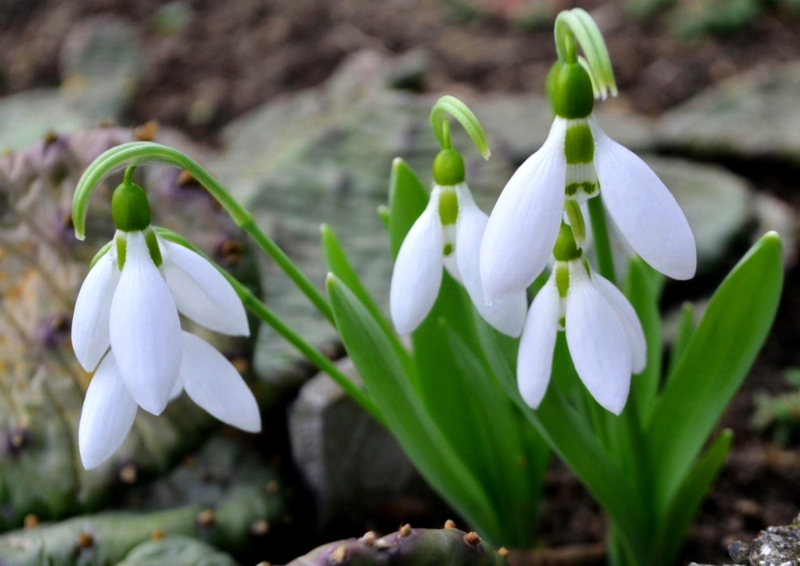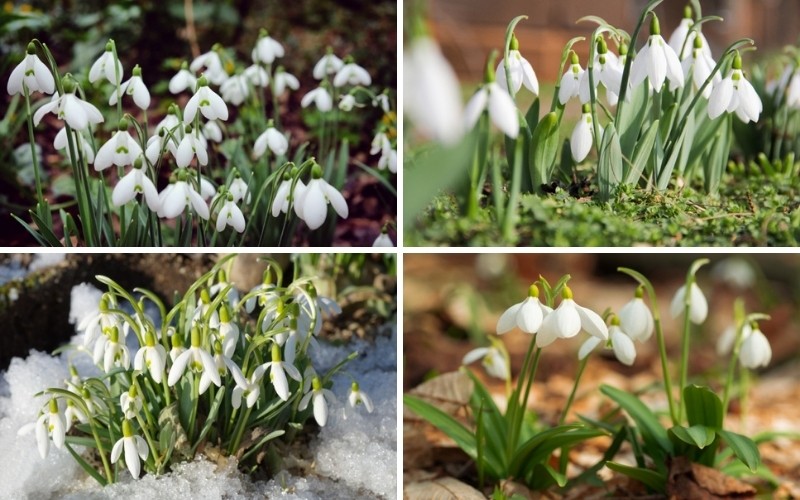
Snowdrops are flowers that grow well in cool temperatures, and they won’t grow well in hot zones. They will grow in zones three through nine. The various varieties will grow anywhere from 6″ to 12″ tall. They will bloom from February through April.
The bell-shaped flowers are small and white and have a lovely fragrance that smells similar to honey. They may have green tips or other green markings. Each snowdrop flower has two sections of three lobes.
The snowdrop is popular for how early they bloom as well as how little maintenance they need.
They love cool temperatures and are often planted in large numbers because of how small each individual plant, and flower, is. Planting about 25 of them together is enough for a nice patch of snowdrops.
Light and Temperature Requirements
Snowdrops can be planted in conditions from light shade to full sun. They can be planted under deciduous trees that get their leaves late in the year. This allows sunlight to get through to the snowdrops in the early spring when they are growing and blooming. Don’t plant them under evergreens, as the foliage will not allow enough light through.
Watering
When you first plant snowdrop bulbs, you need to deeply water them for about 15 seconds. This will help the roots to start to grow. Do this deep watering once every week for the first four weeks. It’s best for the soil to stay slightly moist during this time, so water them a little more often if you notice the soil going dry. After that, your snowdrops will not need as much water. However, if you live in a warm climate, they will need more water than if you live in a cool climate, as the water will evaporate more quickly.
Soil and Fertilizing
The soil that you use for snowdrops should be humus soil with plenty of organic material in it. It must also drain very well. When you are planting snowdrops, it’s good to loosen the soil and to add dried manure or comport to the soil and to mix it all together with fertilizer. Use a granular, 5-10-10 fertilizer and mix it well so that there are no clumps. If your snowdrops are in a container or planter bed, you can then fertilize them about every 10 days after the foliage starts to grow and keep fertilizing it until the blooms wilt. Every fall, mulch the bulbs with a little compost.
Deadheading and Pruning
When a snowdrop bloom is spent, deadhead it to keep the plant looking better. When the foliage begins to wilt, don’t trim it until it becomes yellow. This allows your plant to store up as many nutrients as it can for the following year. The foliage will wilt on its own, but you can cut it back until it is just above the soil to help keep the plants tidier.
Propagation
Seeds are not a good way to get a snowdrop plant started. They often won’t grow at all from seeds. Instead, concentrate on the plant’s bulbs. Plant the bulbs with the flat base of each facing down in the soil. The thinner, nose portion should be face up. Plant them about 5″ deep so that there are just about 2″ of soil sitting on top of the bulbs. Water the bulbs at least once a week, and check the soil to see if it is dry or moist. Snowdrops will multiply by creating daughter bulbs from the ones you plant. Every couple of years, you can dig up the bulbs and divide them to keep the snowdrop population under control.
You can also propagate them by dividing and replanting the new bulbs that have grown. If you do dig up the extra bulbs, don’t leave them out of the soil for long, or they will get too dry to plant. Wait until all of the foliage has died down to dig up the bulbs. This will be anywhere from late spring to the early fall. Plant them at that time and don’t disturb them until they have bloomed. It will take that first year to become established. The second year, they will have more blooms and start to multiply again.
Pest-Free Plants
If you have a garden or flower bed where pests have been a problem, snowdrops may be a good solution. They are not attractive to pests and they rarely get any diseases. They are even resistant to deer, rabbits, mice and chipmunks. It’s a nice flower to grow in rural areas where pests have been a big problem for the foliage.





